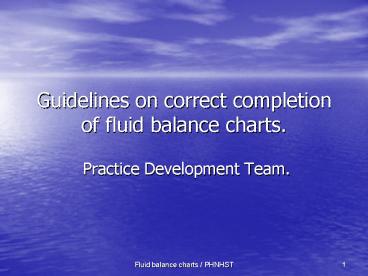Guidelines on correct completion of fluid balance charts' - PowerPoint PPT Presentation
1 / 13
Title:
Guidelines on correct completion of fluid balance charts'
Description:
DO NOT chart the quantity of fluid to be infused. ... Weight important as this can be a better indication of fluid imbalances. ... – PowerPoint PPT presentation
Number of Views:808
Avg rating:3.0/5.0
Title: Guidelines on correct completion of fluid balance charts'
1
Guidelines on correct completion of fluid balance
charts.
- Practice Development Team.
2
Aims and outcomes of session.
- Aim
- To instruct staff in the correct completion of
the fluid balance charts according to Trust
guidelines.
- Outcomes
- Demonstrate the ability to correctly complete and
calculate a fluid balance chart with the use of a
clinical scenario. - Explain the need for correct and accurate
completion to colleagues in the clinical
environment.
3
1.Confirmation when to chart data.
- If IV fluids via normal giving set, charted as
name of fluid and when due. - DO NOT chart the quantity of fluid to be infused.
- At 06.00, 12.00, 18.00 and 24.00hrs chart the
amount of fluid that has been titrated and add to
running total. Also chart on completion.
4
Cont-
- On completion of the bag, double lines should be
drawn below to indicate completion. - If IV fluids are given via infusion pump, it must
be recorded hourly and added to running total. - Chart to go with patient to theatre and recovery
staff to complete with a cumulative total.
5
Agreed heading of columns.
- Both input and output columns have blank
headings, this is to allow for wide diversity of
needs throughout clinical areas. - Each clinical area responsible for deciding
format of columns according to need.
6
Cont-
- Awareness that all forms of input and loss need
to charted, especially IV drugs and enteral
feeds. - IV Drugs are mixed with a fluid medium and
potentially can increase input by a large amount.
7
Confirmation of standardised values.
- Now agreed standardised quantities of certain
fluids on guidelines for chart. E.g. cup sizes. - Other fluids have quantity indicated on
packaging.
8
Importance of urine and running totals.
- There is now a running balance that MUST be
completed. - If patients are catheterised and do not require
frequent measurements, the agreement with
Infection control is to empty and chart 12 hourly.
9
Cont-
- Clinical judgement is required to indicate if
measurements need to be more frequent i.e.
hourly. - Average acceptable urine output is 0.5mls/kg/hr
i.e. for a 60kg patient it would be 30mls. - Required to maintain functions of kidneys.
10
Need for registered nurse signature.
- Any healthcare professional can complete chart.
- Responsibility of trained nurse to sign at
indicated 6 hourly intervals. - Enable assessment of fluid status and
identification of potential problems. - Drs can be contacted and review treatment in the
day wherever possible.
11
Need for 24 hour view.
- Ensure patients balance is transferred from
previous day. - Weight important as this can be a better
indication of fluid imbalances. - Completion of 24 hour running total charts is
essential including a cumulative review. - Charts MUST be filed in patient notes.
12
Conclusion.
- The fluid chart monitors patient fluid status. It
is a legal and professional requirement to
complete this accurately. - NMC guidelines for records and record keeping.
Page 9 - NMC code of professional conduct 4.4 and 4.5
- There is no excuse for omission!!
13
Recent fluid chart audit
- Ward 7, 1Z, 3X
- All less than 33 completed fluid balance
charts!!! - Discuss..































